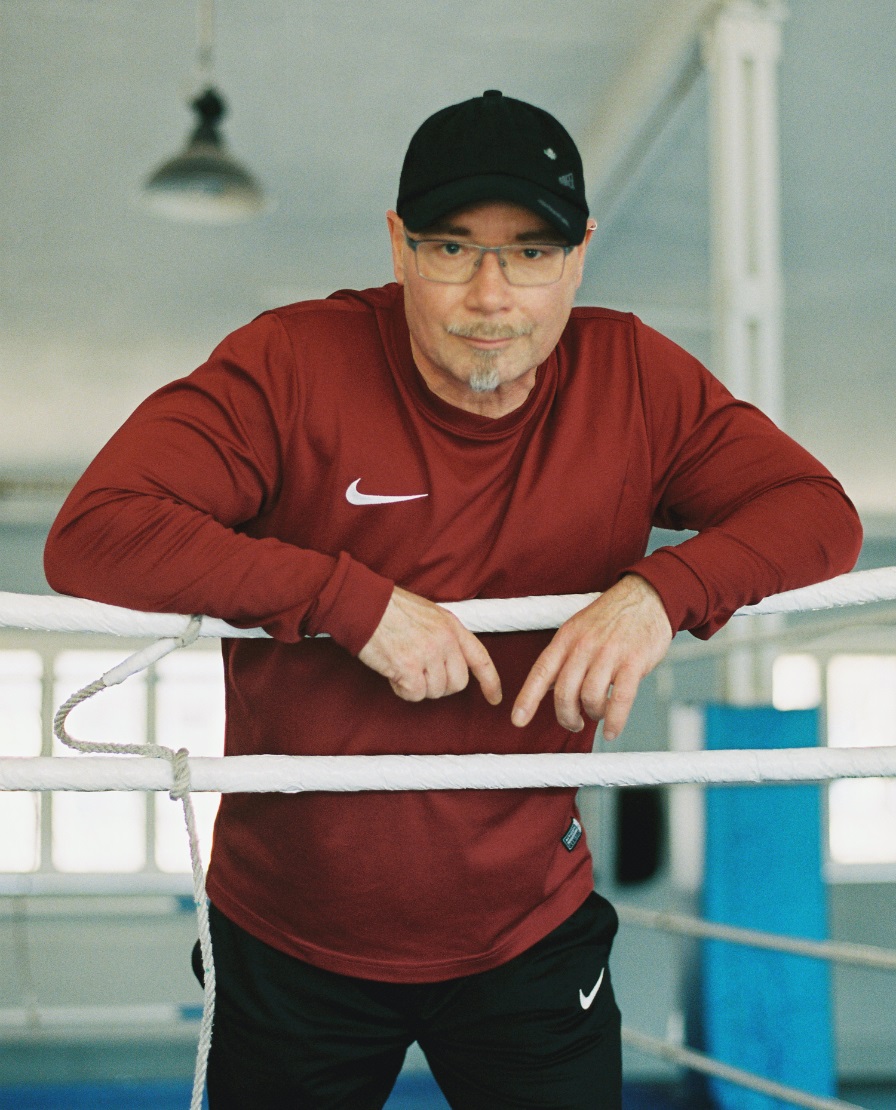
Robert Rode first started working as a personal trainer in 1988, when he first helped strength athletes prepare for competitions and supported the training of friends, colleagues and actors.
As a powerlifting champion in Berlin himself, he started focussing on strength training and boxing in the 90s, with experiences as a secondary during Germany-, Europe-wide competitions in Berlin and worldwide ones in Los Angeles. Many personal exercise-related experiences, combined with apprenticeships and engagements as a fitness trainer and aerobic instructor created the basis for professional commitments as training leader at Fitness First in 1998 and later at Elixia. In 2002, he founded his company RoRoCoach in Berlin and has ever since been working as personal fitness and back trainer, and boxing and mental coach.
He’s been an author for various journals and a business consultant and coach for his clients since 2008. He loves working with people, where he can mix his unique cocktail of specialist expertise, passion and a dash of humour. He’s an expert for sustainable processes of change, which are based on perpetual continued education and over 10.000 individual coaching with his clients. Travelling to Sri Lanka, India, and Thailand furthered his inspiration and training. Additionally, the contact with Buddhist philosophy and Thaiboxing were experiences that still permeate his coaching sessions today. In 2020, the ‘soulboxer’ idea came into fruition.
The following interviews occurred between Robert Rode and the personal trainer and sports scientist Tim Hermann on the ‘soulboxer concept’, and as a part of the Business Talk on the Ku’damm about the work as mental coach in Berlin.
interview with robert rode
Hello Robert, thank you for taking the time to do this interview, to present to your readers your newest project: the soulboxer. I immediately think of the popular quote by Juvenal, about the healthy mind inside the healthy body — is that a central element of the soulboxer?
Thank you for your questions, Tim. That‘s exactly it: “The body follows the mind and the mind needs the body!” It‘s correct that those of us who have been working in the fitness-, health- and coaching world for a long time know the body isn’t an autonomous, externally remote-controlled machine. Not even with the best training plan or app. The mind is on board as well, wants to be inspired and shows, conducts the way toward a harmonious interplay of body, mind and soul.
The body follows the mind and the mind needs the body!
Why have you decided to start with the soulboxer now? Did a specific event encourage you?
No, the soulboxer isn’t based on just one event or ignition, not on the metaphorical reinvention of the wheel. He’s much more the culmination of the many teachings, trainings, and practical applications of my path. This decision has been growing and ripening for a long time, and can also be traced back to impulses from my own mentor. To me, it was about combining and presenting different training contents that interlock, strengthen each other and create one overarching, comprehensive strategy.
Additionally, it was about the question: Who am I?
I want to pass on knowledge and the strategy of the soulboxer® movement. This I offer as an extensive mentoring program, as continuing education and a complete work concept for consultants, coacher, therapists, and personal trainers.
Do your clients have any inhibitions when they box for the first time? Traditionally, boxing is regarded a rather martial discipline.
Occasionally, those fears do exist, yes, and here, boxing has a therapeutic effect. The contact with one’s own anxieties and the realisation that only the mind turns most of them into some invincible Goliath helps people face their fears in many different areas of life. Therapeutic Boxing Berlin teaches: bravery is acting in spite of fear. There are more than enough opportunities to de-demonise boxing and to release it from the old, cliché box.
By the way, actual full contact occurs very rarely, only with advanced soulboxers and protective gear. There’s many techniques to be learned before the wish of a sparring match can be realised. If that happens, the conditions are set up in a way that minimises risks.
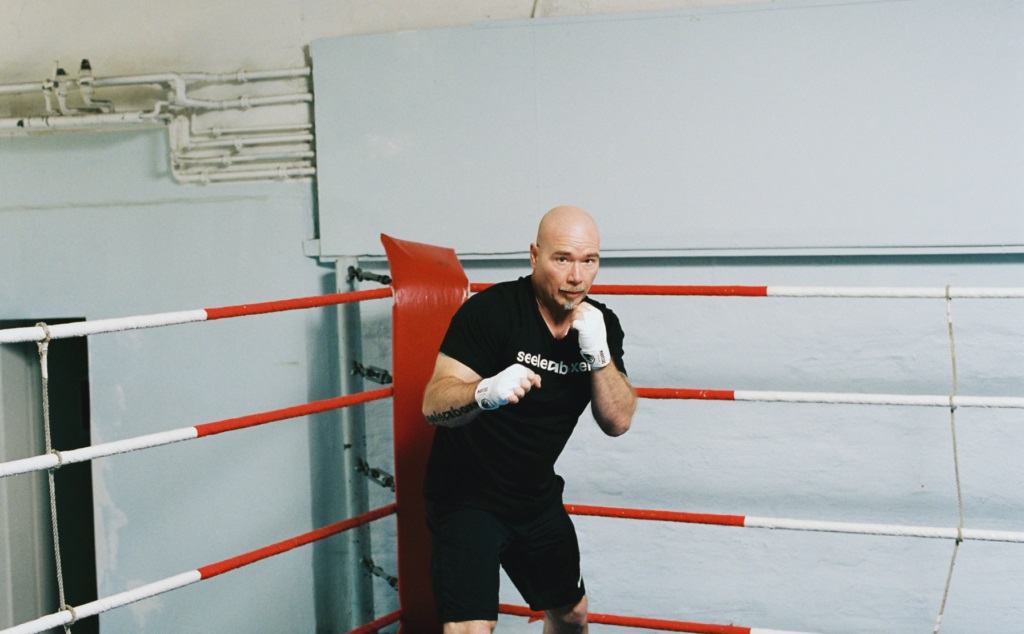
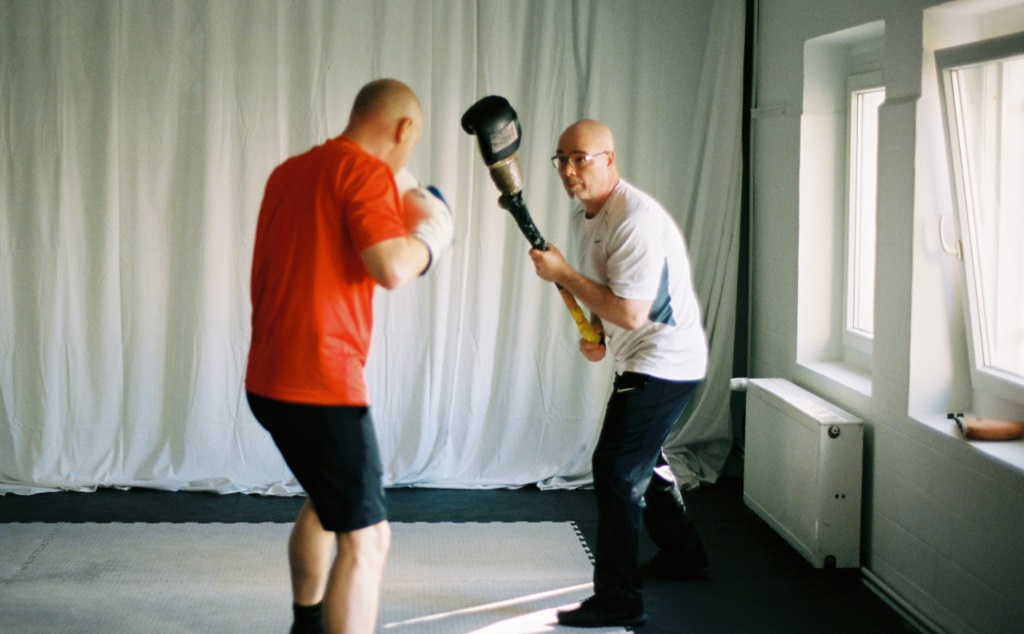
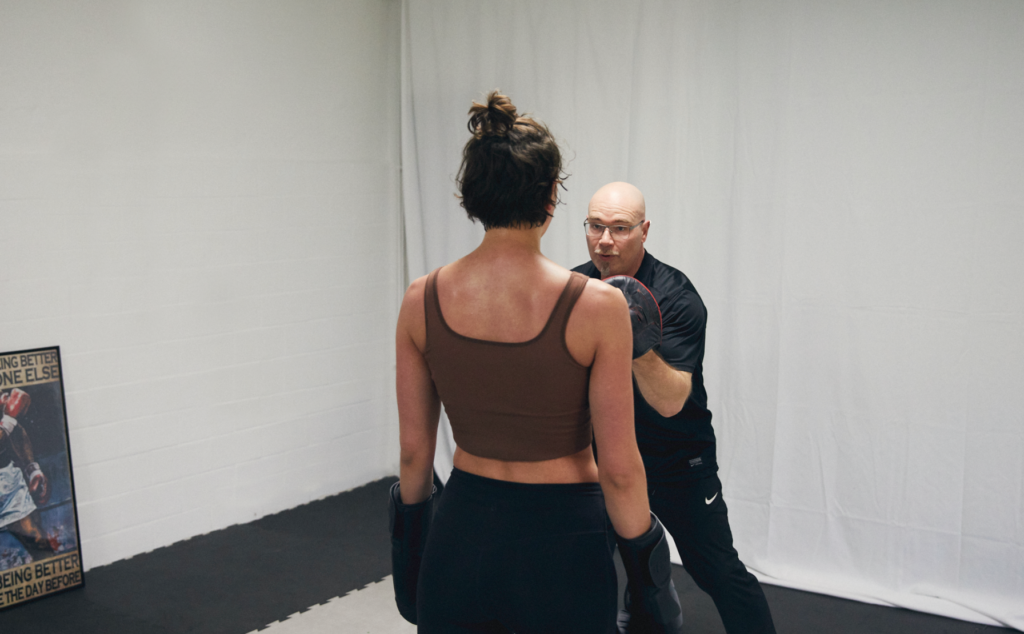
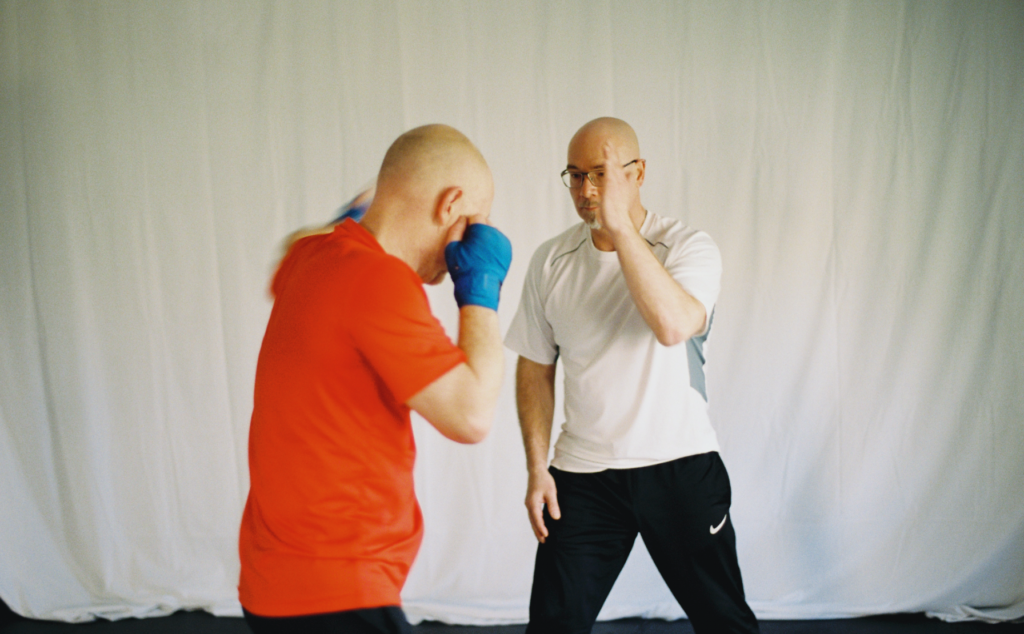
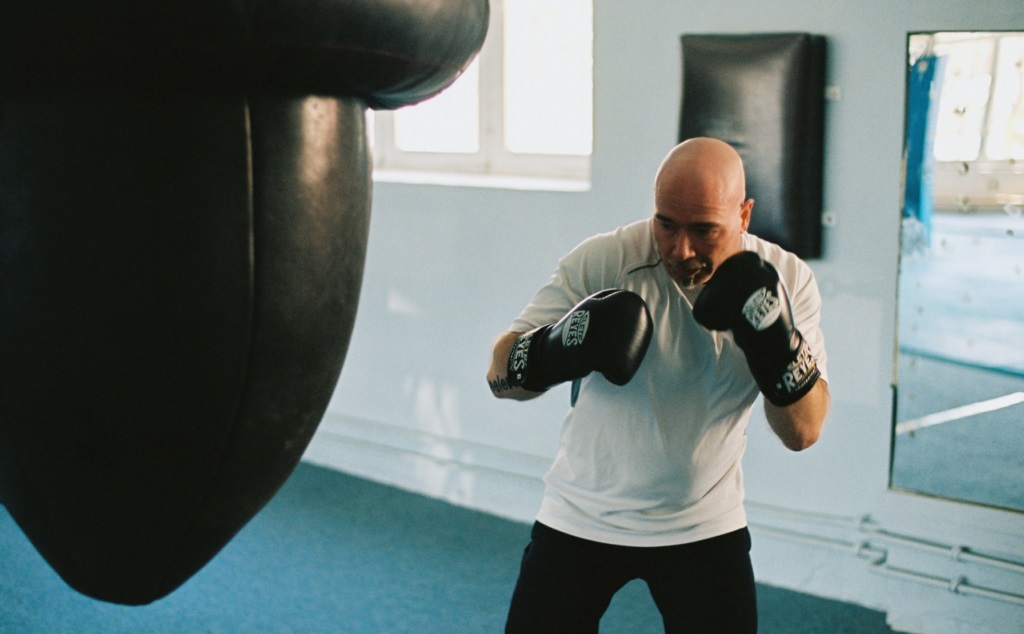
Does the intense confrontation with the own body, the pushing of limits, improve the understanding of the own mind? Can boxing help me with popular topics like resilience and reduction of stress?
Yes, the mind never stops learning, experiences new limits and events, and marvels at what the body is capable of once the mind trusts and encourages it. That, too, are accessible anchor experiences and can allow entirely new experiences with different challenges outside the boxing ring. In boxing, we deal with setbacks and, therefore, we work on our resistance, which definitely increases the resilience.
By the way, resilience research has found evidence for humour, including dark humour, positively influencing resilience. Even though resilience is a very popular topic, one question remains: is resistance at any price, in every area of life, even beneficial?
In regards to stress relief we can see that athletes always leave training sessions feeling better, and looser in a way, than they did when they arrived. Boxing makes people peaceful. Of course, that’s only sustainable when combined with work on ‘stress management’.
You describe yourself as a (Boxing-) Therapist – is it in the end not about the physical exertion, but exclusively the mental background?
No, not exclusively, it’s about the combination as a whole. Boxing works as an excellent transporter and solvent, and, on top of that, is one of the most intense fitness trainings. Bodypsychotherapy, which involves improving one’s posture and movements is definitely more popular than boxing therapy. By improving posture and movements, or learning new ones, we’re sending positive, success-related signals to the mind, we feel more content, even-tempered, healthier and more resilient.
Working muscles interact with the brain and initiate the creation of certain neurotransmitters, which are popularly referred to as happiness hormones. They improve our mood. For that alone it’s worth it to get the body moving.
The term ‘soul’ is a rather mystical expression for something that is difficult to clearly define in our culture. Why did you decide to use it?
You’re right, the soul is not a limb like an arm or a leg, but it does live inside the body and is defined differently depending on religion or culture. In any case, it’s commonly used in our every day language and there does exist a general collective understanding of what it is. The widespread consensus is that it’s the cluster of all emotions, moods and mental processes in a human. The soul is whatever is thinking, feeling, and remembering. The ‘I’.
By the way, the greek word for soul is ‘psyche’ (Ψυχή). That’s why I don’t think programs solely focused on movement are sufficient when we’re talking about so-called holistic fitness. Not if the soul is lacking something, or if it wants to let go of or archive something. The soul is usually not suffering because the biceps is too small or the stomach to chubby. Does something go well if it happens soullessly? I don’t think so. All that physical training is only of any use if the soul actually wants to live inside the body. That’s why ‘soul’ seemed very fitting for this concept.
What topics do your clients come to you with? Is there a specific pattern?
You’ve already mentioned ‘stress’. Stress is the number one trendy term right now, which can be carried around by people like a trophy. Even though it’s really just a superficial and consciously selected ‘definition’, it does suggest a pretty deep structure in the subconscious. Stress means something different for everyone. The question is what lies beyond the individual stress pattern, where do these stressors appear, and what feeds them. Very quickly we then arrive at topics like self-esteem, self-love, and fears in its many forms.
Sometimes, people are stuck in mental and physical exhaustion, accompanied by a pessimistic thought spiral. It’s crucial to find the roots here, which usually go far back into childhood. This cause cannot be thoroughly examined between squats, sit ups, shadow boxing and a protein shake. That’s why mental boxing exists, as a separate category with extensive thought gymnastics and mental hygiene. I think it makes sense to follow an interdisciplinary approach, after an appropriate consultation.
On your homepage you wrote that we can at least learn from our failures. Is that a motto of yours – that we should always get up more than we fall down?
This refers to the basic formula of a boxing match on how to deal with getting beat down. That can be hard, but still many matches are won after being on the ground. I have to stand up and want to face my opponent again. However, that’s not always possible. Then, we have to accept our failures, live with and learn from them, reorient ourselves, and start again. That’s true outside of boxing as well. Failures are the secret ingredient of success.
Do your clients need any specific characteristics? Who’s allowed to come train with you?
Yes. They have to have an inner flame of motivation and the desire to change for the better. That’s how we can create a fire together. ‘Together’ is crucial here, we have to want to create a reliable team. The desire to want and to do is a basic characteristic we develop further. Not having any enthusiasm to change something that restricts or hinders won’t work. As I’ve said earlier: exercise and animation from the outside alone is not enough.
In your writing, your emphasise the special connection with nature – does that play a role in the training with your clients? Where can the soulboxer be found?
The soulboxer is not tied to one specific place, even though there are preferred camps. The main place for training is Berlin-Brandenburg. In collaboration with the legendary boxing gym and museum ‘Zur Ritze’ in Hamburg and boxing camps in Thailand, several workshops and ‘soulboxer days’ are in planning. But back to nature, which is always playing an important role, if only because we spend too much restrictive time sitting at our desks.
Nature can teach and heal. For good reason has forest bathing been considered a preventative health measure in Japan since the 80s. Numerous studies have found evidence for the forest’s effective power. It’s about diving into nature, in the connection with it; perceiving with all our senses, removed from all noisy distractions and digital disturbances. And yes, clients are usually on board with that, depending on their individual topics.
You have been supporting clients as a business coach for a long time. How did that come about?
I want to support my clients comprehensively, not just physically or mentally. The word ‘personal’ is at the forefront of my work. Weak leadership is mostly due to the management staff themselves, much more rarely due to structures, conditions, or the workers. “The fish rots from the head down”. Companies can only flexibly realign themselves and deal with increasingly dynamic changes if the people inside it change.
All this starts with the management, especially if it has already turned into the biggest part of the problem. Sometimes it’s about putting people in a state that makes physical training possible in the first place. Personal problems are often a hindrance to business and the task of managing people. Everything is connected and has to first be detangled to achieve clarity.
If your clients tells you about insolvency, layoffs, crises, and conflicts, fitness training won’t solve these problems. Spending over 20 years day in and day out with managers, entrepreneurs, and CEOs comes with a lot of input. You end up having access to a wide archive of business-related situations, problems, and their respective solutions. Or the knowledge of how things don’t work. If you listen closely, you can learn a whole lot about inner and outer communication, about structures, leadership, personality development, team building, recruiting, cooperations, acquisitions, processes, and guidelines.
I don’t need to intimately know the individual industries to be a helpful reflector and sparring partner. Depending on the situation, I support births, developments, or funerals. In many ways, management trainings are similar to learning the didactic ABC of boxing. Internalising basics allows an individual style to emerge. The case of the individual leadership style matches the variable lead hand in boxing. I want to add, however, that I consider anyyone who leads their own life a leader.
You include very unconventional elements in your workouts. Do your clients accept that?
You bet! ‘All jokes aside’ is a very common phrase in Germany. As if anything worked even remotely better with less fun involved. I don’t want to bore neither me nor my clients with dust-dry physical exhaustion. This could potentially have a demotivating effect in the long run. And strong individualists or creatives surely won’t stay motivated by purely conventional workouts. That’s why I think variety and fun are boosters for better learning, and for installing new patterns of thought and behaviour.
Beyond that, such unconventional things help bring things to the surface and in motion. They’re building blocks and tools that don’t assume to be the sole cure for anything. If you hint at the junkyard-workout, that is one of those tools. Anyone knows that hurt parts of the soul cannot be repaired with a sledgehammer. But we get to start a conversation about anger, trauma, violent experiences, and shame. It would be a huge loss not to talk about these things.
What is, in your perspective, the most important thing about personal training with people? What advice do you have for young colleagues?
Offering the client a space in which they are safe to drop all day-to-day masks. Only in a trust-filled environment can an athlete be open, can something grow and bloom. To summarise: empathy, tolerance, listening, and humour. Young colleagues I tell: don’t be your clients’ judge or persecutor, be their defendant. Learn to lead yourself the way you want to lead others.
Do you consider your work a contribution to society?
Absolutely. Being able to accompany people in their change-work is grateful work. Watching how their change starts positive impulses in their environment, be it personal or professional, shows its radius. And the worth of the individual’s mental and physical balance, meaning the health of society at large, is undisputed. Insurance companies are relieved of some burdens, the impact of partially amiss politics on healthcare is softened. In that, I do see a degree of societal impact.
To conclude, maybe a philosophical question: is life in the end maybe just a fight against ourselves? How can we win?
You mean “Everyone is their own biggest enemy”? There is some truth in that, if we look at the programs of self-sabotage many people have internalised. Imperfect, hurt, or weak personality aspects are often fought against or rejected by ourselves. This just weakens us even more. The first step in avoiding fights against ourselves is accepting those parts and having them join our inner team. These parts too have enormous qualities and strengthen us overall. I think the approach of fighting for those personality parts is worth it more than fighting against them. Even better is dancing with them. For more dancing than fighting in life.
“Business Talk on the Ku’damm”
Can you give us an example of when you helped a client overcome their fears?
Aside from various anxiety disorder listed in the anamnesis, fears of flying and exams are arguably the most prominent. I can clearly remember the case of a women complaining about intense discomfort and avoidance behaviour at just the thought of entering a plane. A young women in her mid 30s, standing with both feet on the ground, hasn’t been on a flight since her childhood. At first, we identified the reference experience and the situation which triggered the fear, to then later work with and transform those stored emotions, feelings, and bodily reactions.
Bravery is acting in spite of fear.
If the memory is hazy, this always happens with the help of a kinesiological muscle test, which is quite reliable in achieving the aforementioned goals. It’s very difficult to manipulate the reactions of our muscles and physiology to specific questions about the past, which makes the technique very conclusive. These muscle tests are a very exact diagnostic tool and are by now indispensable for my work. That’s how we systematically excluded many things, and arrived at a specific experience she had at five years old.
During a flight with turbulence, her grandmother next to her reacted with panicked behaviour, which had to be uncomfortably regulated by the flight attendants. The client could consciously reproduce this scene in front of her inner eye, including all the uncomfortable accompanying emotions. She learned her fear of flying by observing her grandmother. This incident and its emotional consequences had never been addressed and therefore not rationally processed before.
Then, I often ask the question: How do you create your fear? A classic coaching question that always opens doors and has lead to many sudden realisations. That’s because the client realises that they have to imagine the fear in order to have it. In their mind, they live through the anxiety inducing situation again and again, even though it might have happened decades ago and is currently irrational. Sometimes, the image alone has turned into a horror scenario.
At first, it was important to create a temporal and physiological distance to this igniting moment, in which she as an adult watched the scene as a distanced, external observer. This switched perspective and changed nature of the memory also influence the impact it had on her body. It’s usually possible to adapt a more relaxed attitude. Subsequently, techniques that support bilateral hemispherical stimulation and the connection between the two hemispheres are very helpful, and surprisingly so. The left and right hemispheres are more effectively connected, and the emotional and rational levels linked, which allows a new evaluation of the ‘old fear’ to occur. That’s comparable to the so-called REM – the phase of sleep in which experiences are being processed.
Additionally, we worked with hypnotic trance-journeys and positively suggestive linguistic patterns. This was all about letting old emotional memories fade away in favour of a happy anticipation to flying. We created an emergency anchor, consisting of a technique for the aforementioned linking between the hemispheres, and with controlled and calm breathing. (Though this emergency never happened.)
Immediately following the last session, my client booked a flight to the south. This confrontation with the old fear is of central importance, to rewrite old anxious patterns with a new, positive experience. The client was able to progress professionally and nowadays flies regularly for her job.
How do you approach the identification of limiting beliefs?
The belief that absolute truth consists of one’s own experiences, thoughts, learned behaviours, and the resulting emotions and feelings is a crucial cause for limitations and obstructive convictions. All this is just the perception of the client’s personal perspectives on the world and their experiences. It could be said that their perception is influenced by their own interests. They live and see what they have experienced and what they believe in.
“I can’t do this” is arguably the simplest of these convictions, which for some has been cemented as a solid belief in their life. What is stopping you from believing something else, and what do you need for a new belief? I often add that freedom of faith exists in Germany, after all. The client gets enough time and space to think. Usually, the answer is roughly this: new experiences and/or bravery. I then encourage the client to succumb to ‘bravery attacks’, to realise these new experiences.
Here, it’s important to mention that humour is an essential way to transport new linguistic bridges to the client, and to install it in them either directly or indirectly. A funny story involving a suggested solution can be helpful here. Sometimes people ask me as a mental coach: What do we need these days, to get through all the overlapping crises unscathed? Humour. Resilience research agrees with me here, as it understands humour as an elemental supportive factor for strong resilience.
Furthermore, I often apply questions from the field of resource-oriented communication to foster potential. The classic W-questions allow us to access the deep structures and origins of beliefs. More often than not, it was other people’s convictions and limitations that got projected onto children, and then unfolded their hindering effects far into adulthood. Sometimes, key events in school, upbringing or work caused “I can’t do this”, similarly to fears. These too need to be overridden with positive experiences to install new beliefs.
Do what extent does empathy play a role in your work as a mental coach?
When working with people, compassion is of great value, and cannot be replaced by pure professional expertise. Empathy is the spark igniting a good relationship between client and coach. Empathy is the requirement needed to create rooms of safety for the client. That’s the only way for the client to achieve true openness.
When working with a ‘broken heart’, the scalpel needs to be lead with a healing hand, similarly to an open heart surgery. Peaceful language, humanity, and compassion allow tools to be used gently and sensitively. A mental coach’s own sensibility and emotional competence are valuable and especially humanitarian capital.
How do you prepare a client for a challenge or an exam?
It’s all about encouraging the client from the start to create a scenario of success, and to visualise it with all their senses. The desire to win has become larger than the fear of losing. If real experiences of failure created an insurmountable fear, it’s important to transform it. As I’ve described above, it’s necessary to show the client techniques with which they can put themselves into states with a positive mentality and basic physiological tension, right before an exam for example.
Depending on the context, we practise with the client’s self-image, e.g. regarding public speaking. We improve their self-perception by training with their mirror image and video coaching sessions. One or the other presentation was born this way. Meetings and conversational skills have been improved, crisis interventions executed more confidently, or the termination of toxic relationships practiced in sparring duels. Additionally, entrance exams for the police force, fire brigade, or driver’s license were targets of such preparations.
How do you integrate meditation and breathing exercises into your mental coaching sessions?
My mental coaching creates a supportive symbiosis between body and behavioural therapy. This includes a therapeutical boxing training with a body meditation, which consists of shadow boxing in slow-motion and Qigong. The client has to focus very well, as their breathing adapts to the calm and flowing movements. This kind of training promotes the serenity of body and soul. Guided meditations with hypnotic language patterns allow the regular calm breathing to form a part of the overall soothing effect.
Other breathing techniques are also a part of the settings, and can be integrated regularly into the individual life contexts. The client is motivated to turn these methods, e.g. deepened diaphragmatic breathing or alternate breathing through either nostril, into habits in little daily breaks. Here, coaching works mainly as a help for better self-help.
How do you work on supporting your clients’ positive mindsets?
Mindset and resilience are both popular and commonly used terms, though their definitions aren’t the same for everyone. ‘Mindset’ simply describes the way someone thinks. It’s clear then, that the mindset has an enormous impact on the quality of our lives. Our mindset consists of many parts, influencing or even modifying it can therefore seem like a daunting task at first glance. It’s formed by the sum of our mental and behavioural patterns, values, convictions, experiences, assumptions, principles, abilities, knowledge and self-image. Additionally, it’s influenced by the crises, illnesses, and strokes of fate we have overcome in the past.
If we imagine the aforementioned components as liquids and mix them, we can view the resulting cocktail as our mindset. If we then want to influence or positively modify it, we have to systematically examine and work on each individual part. To achieve this, I work with various formats, mainly to create new frames of reference and meanings for past negative experiences. Reframing is one of those techniques which gives the client different options for a new perspective and, consequently, a stronger mindset.
at a glance
I was born in the depth of winter and, naturally, developed a love for summer. One year later, in the spring of 66, it was finally time: I took my first steps and started my sports CV.
From then on, I annoyed all grown ups with my desire to move. I wanted to add movement to my life very early on, which wasn’t always met with understanding. ADHD didn’t exist yet, so I was just a very fidgety child. For a long time, I perceived ‘the real world’ as a zone without fun and truth. But jokes aside: I won’t count the usual hierarchical and seamless rungs on my ladder of success and career. Not that they didn’t exist. But to me, the really relevant stages were called breaks and ‘wounds are treasures’.
Today I can afford to describe what it’s like to grow up in a difficult, non-academic environment with methodological punishment. I was made to believe life isn’t a ‘walk in the park’. An inherited belief system that made certain paths much more difficult, because it believed more so in the bird in the hand than the two in the bush. Key tasks on the road to maturity were learning how to study, accept, and forgive. Never easy, but possible with a lot of patience. The outer facade hid the inner wounds, which received intense affection later on.
I was allowed to learn how to find and fight for self-esteem. How to scale the mountain as an outsider, away from the established tracks. Learning how to overcome by falling down. At first in the praxis, then later acquired and properly trained. 5 learned professions later, and 25 years of professional experience in the coaching world, and being the one who now recruits the best trainers; all of that has shaped me. Much love to Gerda and Helmut, but I moved on to search for other springs of inspiration. I found what I was looking for. It was mostly the power of encounters that got be back on track and inspired me time and time again. Because people need people. I realised education is everywhere, invitations to it not so much.
Much of what I have access to now is theoretically teachable in studies, apprenticeships, and seminars, but not experienceable. Today, I am very grateful for my extensive experiences. I want to use this opportunity to mention how boxing was immensely helpful for me to overcome crises and trauma. I would be more than glad to talk about the history or my travels, paths, and milestones in person.
Zukunft braucht Herkunft! (Future needs history) (Odo Marquard, 2003)
Achieving clarity on what is and what should be is the beginning of any desired change. Because the clarity of words decides the usefulness of things. No matter if we want to receive or rid ourselves of physical or mental things, the entry point is the same. After an extensive inventory, we will be in the clear about where you really want to be. Once we know the Why and the direction, choosing the correct tools and methods for you is easy. Let’s clearly state everything essential, the wishes, chances, but also the challenges; as simply as possible, but no simpler than that.
Only the consequent action decides the value of the spoken words and resolutions. Actually using the chosen strategies and tools means igniting the engine for your success. When you look back on your past successes, you’ll quickly realise that achieving milestones required consistently laying the groundwork and making decisions. We can use this knowledge to our own benefit. Decisive action is our credo, because someone who’s looking at every cloud will never travel. With this in mind: “towards your goal with all consistency”.
When it comes to learning and establishing new abilities, nothing is as valuable as repetition. That’s deep inside us, ever since we learned how to walk, when failure was not an option for us. Training to not stand still, but to keep walking was key. The ‘again and again’ strategy is the simplest and most effective method I got to know in my life as a trainer, it beats any short term strategy. Doing something regularly and sticking with new habits will lead you to your balance. I will be by your side during this process of change, continuously and with all my help and advice.
Personal Trainer Diploma (IFAA)
Fitness Trainer A-Licence (BSA)
Fitness Trainer B-Licence (BSA)
Trainer for Sports Rehabilitation (BSA)
diverse Aerobic Apprenticeships (SAFS & BETA)
Boxing Trainer Licence (Federation of Professional German Boxers / Bund deutscher Berufsboxer)
Massaging Apprenticeship (SAFS & BETA)
Back Trainer and Educator (BSA)
Hypnosis Coach (Wege Academy)
NLP Practitioner (Kikidan)
Mental Coach (BSA)
Boxing Therapist (PITT- Institute für systemic trauma work, trauma & sports)
Robert Rode is a member of the federal association Personal Coaching
-
one-on-one personal mental coaching
-
improving physical and mental fitness- “Soulboxer Plan”
-
personal boxing training, boxing lessons, therapeutic boxing for trauma, anxiety, depression, burn out
- personal boxing and mental training for managers, and entrepreneurs / business coaching
-
video training
- outdoor training, TrimmGo
-
progressive muscle relaxation, EFT tapping techniques, bilateral hemispherical stimulation
-
back training, training of the musculature surrounding the spine
-
weight loss, weight management, nutritional analysis
-
functional, sensorimotor, strength training